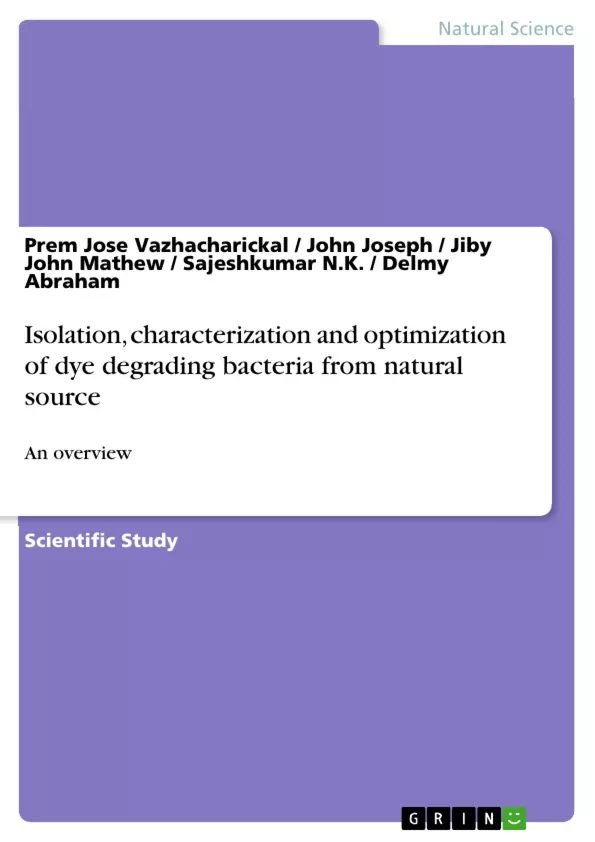In this study an attempt was made to evaluate the colour degradation capabilities by collecting the contaminated soil sample from Kalady area and serial dilution was done upto 10-6. From the dilution 10-5 was taken and spread plated on Nutrient agar. From the above plate, isolated colonies was obtained which was found to be Bacillus sp and Pseudomonas sp respectively by morphological, microscopical and biochemical method. The isolated colonies was taken for degradation studies with 1% dye and 1% inoculum in Nutrient broth and OD values and colour change was noted. It was found to be Bacillus sp has more degrading capacity in yellow colour than Pseudmonas sp. The optimization studies was done with Bacillus sp having different concentration of colour (2, 4, 6) with varying pH (4,6,8) and temperature (37°C, 40°C and room temperature). The result was found to be having the concentration of colour with 4% having pH 4 and temperature 37°C.
Inhaltsverzeichnis (Table of Contents)
- Table of contents
- Table of figures
- Table of tables
- List of abbreviations
- Isolation, characterization and optimization of dye degrading bacteria from natural source: an overview
- Abstract
- Introduction
- Objectives
- Review of literature
- Reactive dyes
- Removal methods
- Physical methods
- By adsorption
- By ion exchange
- By membrane filtration
- Chemical methods
- Advanced oxidation process (AOP)
- Electrochemical Method
- Biological methods
- Anaerobic treatment
- Enzymatic treatments
- Hypothesis
- Materials and Methods
- Study area
- Soil sample collection
- Quantitative analysis of microorganisms present in the collected soil
- Isolation of potential dye decolourizers
- Pure culture preparation
- Morphological and biochemical tests
- Colony morphology
- Gram staining
- Motility test
- Sugar fermentation test
- Oxidative fermentation test
- Nitrate reduction test
- Triple sugar iron agar test
- Coagulase test
- Oxidase test
- Catalase test
- Mannitol motility test
- Indole production test
- Methyl red test
- Voges-Proskauer test
- Citrate utilization test
- Urease test
- Statistical analysis
- Results and discussion
- Dye degradation studies
- Optimization studies
- Conclusions
- References
- Isolation and characterization of dye-degrading bacteria from a contaminated soil sample
- Evaluation of the dye degradation capabilities of the isolated bacterial strains
- Optimization of the dye degradation process by varying pH and temperature
- Comparison of the dye degradation efficiency of different bacterial isolates
- Potential application of the most effective isolate for bioremediation of dye contaminated waste
Zielsetzung und Themenschwerpunkte (Objectives and Key Themes)
The study aims to isolate and characterize dye-degrading bacteria from a soil sample contaminated with textile dye waste and evaluate their dye degradation capabilities. The objectives are to identify the most effective bacteria for dye degradation and optimize their activity.
Zusammenfassung der Kapitel (Chapter Summaries)
The study begins with an introduction to the widespread problem of dye pollution caused by the textile industry and the limitations of conventional treatment methods. The chapter reviews literature on various methods for dye removal, including physical, chemical, advanced oxidation processes, electrochemical, and biological methods. The study then focuses on the isolation and characterization of dye-degrading bacteria from a contaminated soil sample using a series of morphological, microscopical, and biochemical tests. The chapter concludes with a discussion of the dye degradation studies and optimization studies performed with the most effective isolate, Bacillus sp.
Schlüsselwörter (Keywords)
This research focuses on the isolation, characterization, and optimization of dye degrading bacteria. Key concepts include azo dyes, dye degradation, biochemical identification, Bacillus sp., Pseudomonas sp., bioremediation, and environmental pollution.
- Quote paper
- Dr. Prem Jose Vazhacharickal (Author), John Joseph (Author), Jiby John Mathew (Author), Sajeshkumar N.K. (Author), Delmy Abraham (Author), 2016, Isolation, characterization and optimization of dye degrading bacteria from natural source, Munich, GRIN Verlag, https://www.hausarbeiten.de/document/370601


